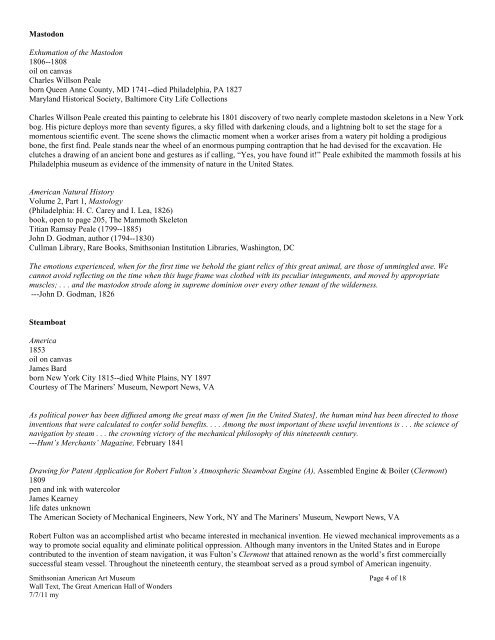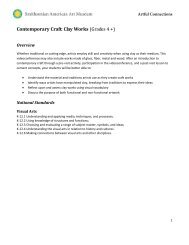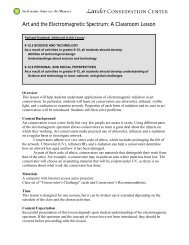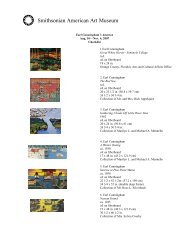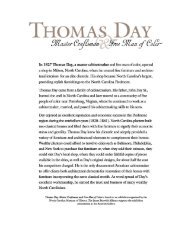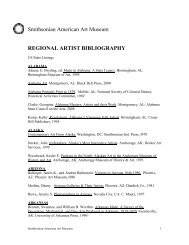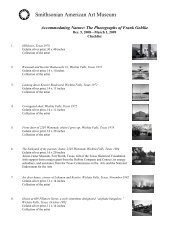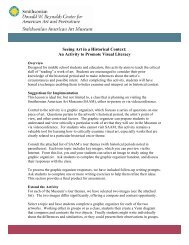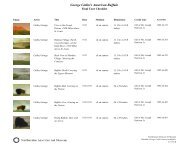Smithsonian American Art Museum - Smithsonian Institution
Smithsonian American Art Museum - Smithsonian Institution
Smithsonian American Art Museum - Smithsonian Institution
You also want an ePaper? Increase the reach of your titles
YUMPU automatically turns print PDFs into web optimized ePapers that Google loves.
Mastodon<br />
Exhumation of the Mastodon<br />
1806--1808<br />
oil on canvas<br />
Charles Willson Peale<br />
born Queen Anne County, MD 1741--died Philadelphia, PA 1827<br />
Maryland Historical Society, Baltimore City Life Collections<br />
Charles Willson Peale created this painting to celebrate his 1801 discovery of two nearly complete mastodon skeletons in a New York<br />
bog. His picture deploys more than seventy figures, a sky filled with darkening clouds, and a lightning bolt to set the stage for a<br />
momentous scientific event. The scene shows the climactic moment when a worker arises from a watery pit holding a prodigious<br />
bone, the first find. Peale stands near the wheel of an enormous pumping contraption that he had devised for the excavation. He<br />
clutches a drawing of an ancient bone and gestures as if calling, “Yes, you have found it!” Peale exhibited the mammoth fossils at his<br />
Philadelphia museum as evidence of the immensity of nature in the United States.<br />
<strong>American</strong> Natural History<br />
Volume 2, Part 1, Mastology<br />
(Philadelphia: H. C. Carey and I. Lea, 1826)<br />
book, open to page 205, The Mammoth Skeleton<br />
Titian Ramsay Peale (1799--1885)<br />
John D. Godman, author (1794--1830)<br />
Cullman Library, Rare Books, <strong>Smithsonian</strong> <strong>Institution</strong> Libraries, Washington, DC<br />
The emotions experienced, when for the first time we behold the giant relics of this great animal, are those of unmingled awe. We<br />
cannot avoid reflecting on the time when this huge frame was clothed with its peculiar integuments, and moved by appropriate<br />
muscles; . . . and the mastodon strode along in supreme dominion over every other tenant of the wilderness.<br />
---John D. Godman, 1826<br />
Steamboat<br />
America<br />
1853<br />
oil on canvas<br />
James Bard<br />
born New York City 1815--died White Plains, NY 1897<br />
Courtesy of The Mariners’ <strong>Museum</strong>, Newport News, VA<br />
As political power has been diffused among the great mass of men [in the United States], the human mind has been directed to those<br />
inventions that were calculated to confer solid benefits. . . . Among the most important of these useful inventions is . . . the science of<br />
navigation by steam . . . the crowning victory of the mechanical philosophy of this nineteenth century.<br />
---Hunt’s Merchants’ Magazine, February 1841<br />
Drawing for Patent Application for Robert Fulton’s Atmospheric Steamboat Engine (A), Assembled Engine & Boiler (Clermont)<br />
1809<br />
pen and ink with watercolor<br />
James Kearney<br />
life dates unknown<br />
The <strong>American</strong> Society of Mechanical Engineers, New York, NY and The Mariners’ <strong>Museum</strong>, Newport News, VA<br />
Robert Fulton was an accomplished artist who became interested in mechanical invention. He viewed mechanical improvements as a<br />
way to promote social equality and eliminate political oppression. Although many inventors in the United States and in Europe<br />
contributed to the invention of steam navigation, it was Fulton’s Clermont that attained renown as the world’s first commercially<br />
successful steam vessel. Throughout the nineteenth century, the steamboat served as a proud symbol of <strong>American</strong> ingenuity.<br />
<strong>Smithsonian</strong> <strong>American</strong> <strong>Art</strong> <strong>Museum</strong> Page 4 of 18<br />
Wall Text, The Great <strong>American</strong> Hall of Wonders<br />
7/7/11 my


